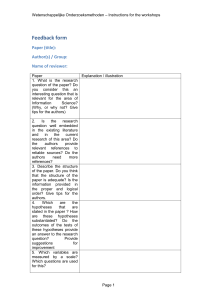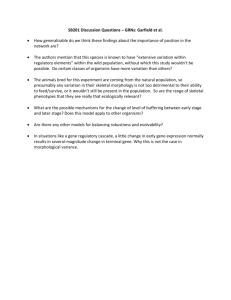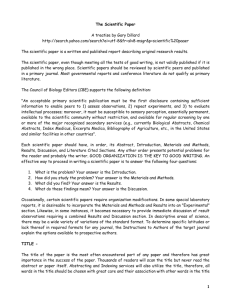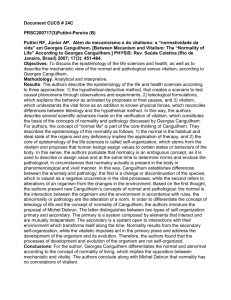experiments authors
advertisement
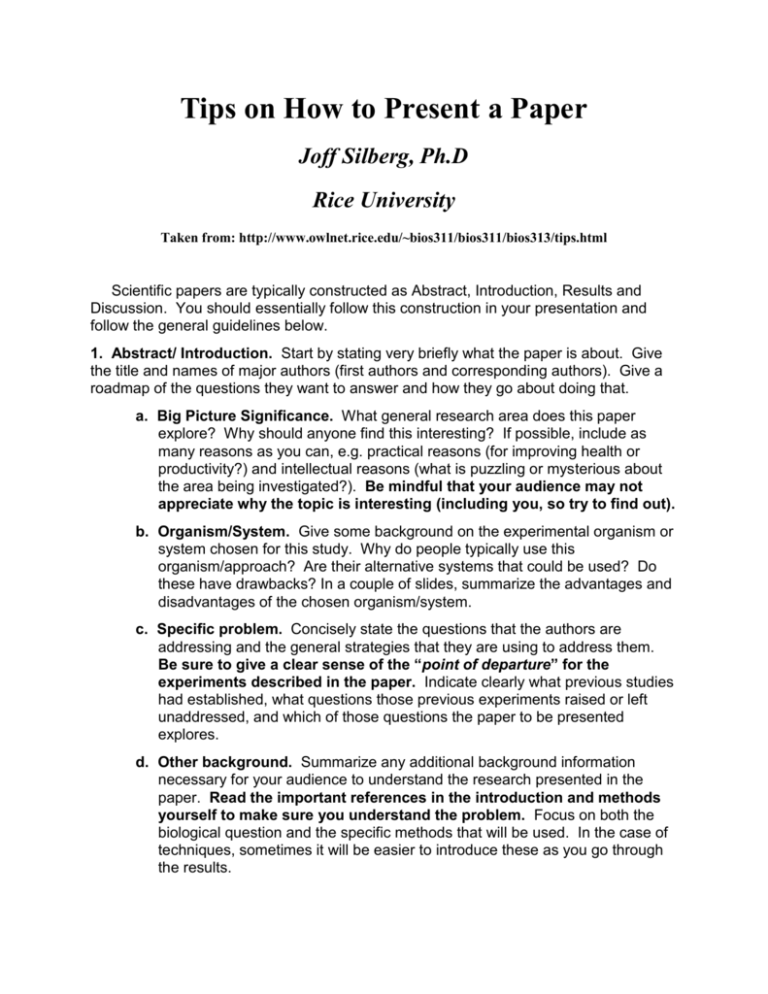
Tips on How to Present a Paper Joff Silberg, Ph.D Rice University Taken from: http://www.owlnet.rice.edu/~bios311/bios311/bios313/tips.html Scientific papers are typically constructed as Abstract, Introduction, Results and Discussion. You should essentially follow this construction in your presentation and follow the general guidelines below. 1. Abstract/ Introduction. Start by stating very briefly what the paper is about. Give the title and names of major authors (first authors and corresponding authors). Give a roadmap of the questions they want to answer and how they go about doing that. a. Big Picture Significance. What general research area does this paper explore? Why should anyone find this interesting? If possible, include as many reasons as you can, e.g. practical reasons (for improving health or productivity?) and intellectual reasons (what is puzzling or mysterious about the area being investigated?). Be mindful that your audience may not appreciate why the topic is interesting (including you, so try to find out). b. Organism/System. Give some background on the experimental organism or system chosen for this study. Why do people typically use this organism/approach? Are their alternative systems that could be used? Do these have drawbacks? In a couple of slides, summarize the advantages and disadvantages of the chosen organism/system. c. Specific problem. Concisely state the questions that the authors are addressing and the general strategies that they are using to address them. Be sure to give a clear sense of the “point of departure” for the experiments described in the paper. Indicate clearly what previous studies had established, what questions those previous experiments raised or left unaddressed, and which of those questions the paper to be presented explores. d. Other background. Summarize any additional background information necessary for your audience to understand the research presented in the paper. Read the important references in the introduction and methods yourself to make sure you understand the problem. Focus on both the biological question and the specific methods that will be used. In the case of techniques, sometimes it will be easier to introduce these as you go through the results. 2. Results. Describe each experiment in the paper. The order of results in the text does not always follow the order presented in the figures. Use your best judgment on the presentation order to best maintain coherence and clarity in the presentation. For each experiment: a. State the hypothesis. Clearly describe what the authors want to demonstrate with each experiment and how their experiments address this. b. Describe the method. Describe the method employed in sufficient detail so that the audience can understand and interpret the results. To do this properly, you will need to read the “materials and methods” section of the paper, and you may also need to consult references that describe the intricacies of a technique, such as the limitations. It is essential to know what you can interpret from a particular experimental result when evaluating the author’s conclusions. c. Show the figures. Crop and blow up relevant panels from the figures for each separate experiment. Make things large and legible so that everyone can evaluate the data on the screen. Sometimes this means that you only show one panel from a figure at a time. However, this depends on the density of information within each figure. d. Describe the result. Go through the data slowly and thoroughly for the audience, i.e. panel-by-panel and sample-by-sample within each panel. Describe why the authors designed the experiments the way they did. Remember controls are always important, especially in providing evidence that new results are valid. Often controls and some results are not presented in figures or tables but are described in the text. Include these in your presentation as they often include important information that supports the author’s arguments. Also include any on line supplementary information in your results. e. State and evaluate the conclusion. For each experiment, indicate the author’s interpretation and conclusions and describe whether you agree with them! This information can typically be found within both the Results and Discussion sections. Typically, the Discussion section gives the broader picture perspective that relates to the overall thesis of the paper. Information from both sections should be included during your discussion of each figure. For every experiment that you present you should address whether you agree with the author’s interpretation and conclusions and whether there are other approaches that would have improved this study. 3. Conclusions/ Discussion. Summarize the overall conclusions of the paper. Make sure you read the references that the authors base their conclusions on, so that you can present and evaluate their argument clearly. State your assessment of the experiments and conclusions in the paper. Did they do what they claimed they did in their abstract/title? Is this novel work? How convincing is their argument after you have critically analyzed their data? How could have this paper been strengthened? What are the next experiments that you think that the authors should perform? General tips. PowerPoint presentations are preferable for accurate reproduction of the figures from the paper. Try to avoid excessive animations, unless they are really required; this can often be distracting. Use a font that is visible in the back of the room on your overheads. Go back to the original journal to copy and/or look at the figures if you can’t make them out on your copy (eg Pdf). If there are movies in the supporting figures, please use them to illustrate the experiments instead of static figures directly from the text. Remember, initial impressions are important for making a good start and will give you confidence during the rest of your presentation. Therefore, successful presenters typically write out and rehearse what they are going to say during the first one to three minutes of their presentations.



